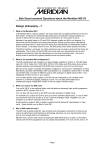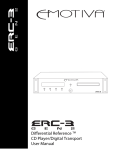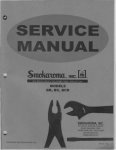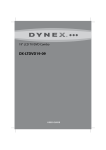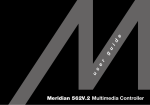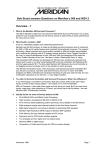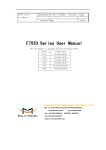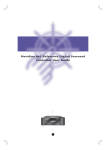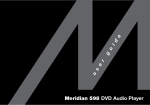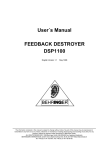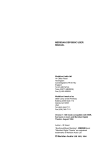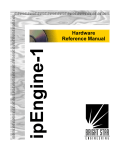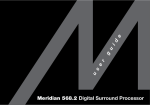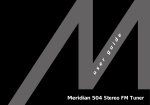Download Meridian 598 Specifications
Transcript
Bob Stuart answers Questions about the Meridian 598 Design philosophy…? 1 What is the Meridian 598? The Meridian 598 is the latest in a new series of optical disc players in the 500 Series. 598 is an advanced, high performance CD, DVD-Audio and DVD-Video player. It features a flexible and high-performance architecture that delivers state-of-the-art sound and picture with a degree of upgradability. Meridian is the world leader in CD and DVD playback quality having set the benchmark with the 800 Reference CD/DVD machine. 598 brings much of this technology and DVD-Audio to the 500 Series. 2 What is the 598 configuration? The 598 plays back DVD-Audio, DVD-Video, CD, CD-R, Video CD, and MP3 using a carefully selected DVD-ROM drive. This player has a modular build. The electronics are split into 4 major PCBs: control, decoding, audio and video and, in addition, the back panel is modular. 598 comes in six variants, each offering a different combination of outputs. For audio outputs you can chose between low-jitter multichannel digital outputs featuring Meridian’s MHR Smart Link or a very high-quality 6-channel analogue output option. Both these options provide an additional 2-channel or bitstream digital output as an alternative feed to a processor or to drive a second zone. 598 has three video options. All offer composite and S Video with variants that provide Interlaced or Progressive Component on BNC or RGB on SCART. The options are clarified in the table below. The 598 can also be your system controller – ideal for building a 2-channel system based on Meridian DSP33 Loudspeakers. 3 Model name Audio Output type Video Output type 598 DC MHR Smart Link Standard BNC 598 DP MHR Smart Link Progressive BNC 598 DS MHR Smart Link Standard SCART 598 AC 6 Channel Analogue Standard BNC 598 AP 6 Channel Analogue Progressive BNC 598 AS 6 Channel Analogue Standard SCART Why is 598 made this way? The modular construction in 598 maximises the likelihood that we can provide a range of suitable options or refinements in the future. Meridian has a proven track record of providing effective upgrades to its products. In fact, its stable-mate 596 will be able to receive some of 598’s features in a future upgrade program. See Q. 87. Page 1 Bob Stuart answers Questions about the Meridian 598 4 Why is a ROM drive used? The 598 uses a ROM drive because this is the best type of drive to ensure accurate data recovery on all disc types while providing a stable platform that can be changed in the future to keep pace with new requirements. For more on this, see Q. 5. 5 How can a ROM drive be so good? ROM drives recover the data from computer discs perfectly. Loading a computer program rarely fails due to the ROM drive. Therefore, extracting the data from a CD or DVD can be done without error. Normally however a computer pays no attention to how smoothly the data flows from the disc. That’s where our special technology comes in. From leaving the drive, the information is in the hands of very sophisticated audio circuitry to get the ultra-low jitter and the highest integrity data. Unlike other players that use a mechanical approach to try to lower jitter by minimising drive vibration, the 598’s memory architecture abolishes this problem forever. In fact, the 598 will often read the data from the disc more than once just to be sure it has it right. The result of this sophisticated effort shows up in ultra-low jitter with sound and picture quality second only to the Reference 800. 6 What is 596? 596 is 598’s stable mate. 596 is a superb CD and DVD-Video player which does not provide decoded multichannel outputs or support for DVD-Audio. Sound issues...? 7 Is 598 a good CD Player? It is excellent! This is very important: CD will be a major source of music enjoyment for many years because the catalogue is so rich and the sound we can get is so good. Meridian has made the best CD players for 16 years, with award-winning models like the 208, 602, 508 and the outstanding 800. 598 uses some of the advanced technology originally developed for 800. The ROM reading system and error correction method provides a very accurate data stream. The 598 then uses three levels of memory-based de-jittering to smooth out the data. The result is musical, clear, smooth, error-free CD playback. 8 How does CD playback on 598 compare to a 500, 506, 507 or 508? The 598 plays more of the CD family than these 500 Series players, it includes support for MP3 on CD-R (or DVD-R). Disc handling is excellent and playability is up to the peerless standard of the 500, 506, 507 and 508. How does the sound compare? As a transport, 598 beats them all; the digital output of 598 has ultra-low jitter. Extra attention has been paid to this output because we see more and more systems built using decoders and DSP speakers. 598 also benefits in Meridian-based systems because you can use MHR (see Q. 15) to get that extra bit of resolution. So, as a CD transport 598 is superior to all but the 800! The analogue output version of 598 is superb and uses 192kHz 24bit DACs in a new configuration. We think 598 is great. Of course it does not provide balanced outputs like 508 or 588. Unlike 500, 506, 507 and 508 the 598 does not provide timecode in its digital output or provide access to index points on CD as these have generally fallen into disuse. See Q. 55. Page 2 Bob Stuart answers Questions about the Meridian 598 9 How does CD playback on 598 compare to a 588? Meridian’s 588 CD is a close relative of 598; many of the same components and principles are used. Their performance on CD is similarly excellent. Obviously 598 is overall a more useful high-quality music player because, even without bothering with the pictures, it can play both DVD-Audio and music from DVD. 588 is ideal for someone who seeks just a great CD player. 10 Can I get 96kHz out of my 598? 598 is fully capable of providing multichannel at 96kHz from DVD-Audio or stereo from DVDVideo. Analogue outputs (if fitted) always run at the highest possible sample rates and digital outputs will also provide 96kHz; sometimes to comply with copy protection these outputs will be encrypted and you need a Meridian system to get the very best result. 11 What about 192kHz? 192kHz is available on some DVD-Audio discs. The 598 is fully capable, the 6-channel analogue output option uses an extremely high quality studio-grade 192kHz 24bit D/A conversion system. Although MHR Smart Link can support it, at the moment there is no industry-standard digital interface for 192kHz. Current 598 software deals with 192kHz on its digital outputs by using exquisite double-precision signal processing optimised by Meridian to give transparent downsampling to 96kHz 24bit. This result sounds fabulous and retains all the benefits of the high-speed recording. 12 But my DAC/Decoder doesn’t support 96kHz. What do I do? There is more benefit from double speed digital audio the further down the chain it goes. If you cannot receive 96kHz don’t worry. For now, use the downsampling DSP in the 598 to feed the digital output. If you upgrade your DAC or DSP speaker then you can turn double speed on again. 13 Does 598 have multichannel output? Yes. All standard configurations of 598 provide multichannel decoding and multichannel outputs. The multichannel output can be analogue or digital, see Q. 2. 598 also has a secondary Aux digital output that can be separately configured as bitstream/decoded and high-rate/low-rate. This output is intended either to provide a second path to a surround decoder or to feed a separate zone. 14 Can I just have stereo? Yes, if you want you can configure the 598 to use only 2 main outputs. In this mode 598 will put out 2-channel from CD, it will pass bitstreams like AC-3 and DTS on to a surround decoder. Movies can also be decoded to 2-channel PCM or only decoded when they are native stereo. In addition, if it suits your system, 598 will access the 2-channel mix on DVDAudio discs. We are very proud of the 2-channel performance and happy that it enables simple playback systems such as a 598 directly feeding a pair of Meridian DSP Loudspeakers such as DSP5000. Page 3 Bob Stuart answers Questions about the Meridian 598 15 What is MHR? MHR (Meridian High Resolution) is a proprietary method for getting the highest possible sound quality in playback systems that use Meridian components like 598, DSP Loudspeakers or decoders such as 568.2 or 861. MHR also uses proprietary encryption and anti-copy techniques to ensure secure transfer of audio streams between elements of a Meridian-only system for the purpose of playback only. It provides a secure copyright protection environment and has the very important benefit of lowering jitter and improving sound quality on all material. MHR is an approved method to pass the highest possible sound quality from 598 to other Meridian products like the DSP loudspeakers. 16 What is audio copy protection? Some DVDs use encryption to protect the audio content. In some cases this carries restrictions on the audio quality permitted on unprotected digital outputs. If you can’t use MHR then 598 always operates so as to provide the highest quality possible. If you have a Meridian playback system that supports MHR (like our DSP speakers, 568.2 or 861) then the 598 is always able to put out the maximum resolution from the disc. 17 What about CD copy protection? In an attempt to stop CDs being copied in computers, some music companies are experimenting with ways of making CDs non-compliant so as to trip up the copying process. Meridian fully supports legitimate copy protection, but we cannot condone ad-hoc techniques that result in so-called CDs that do not comply with the Red Book specification and which may interfere with legitimate playback in CD or DVD players. Meridian cannot guarantee to play any and all such discs that violate the CD Red Book standard and whilst we will make all efforts to support such discs we cannot be held responsible for other companies mistakes! We do make strenuous efforts to ensure that 598 is not troubled by these copy protection methods; so far we have been successful. However if labels choose to degrade the robustness of their discs in efforts to stop computer copying then there may be cases where the music suffers. If you have trouble with such a disc, be outraged; send it back for full credit! 18 Does 598 have upsampling? No. Upsampling requires a DSP resource that 598 does not have but that can be provided by an associated 568.2 or 861. Upsampling is a feature of 800 (also see Q. 5). Video issues…? 19 What is video copy protection? Meridian 598 uses Macrovision analogue video copy protection to prevent DVDs being copied on VCRs. This is a mandatory feature of all DVD players. The copy protection will not interfere with picture quality so long as the display device is reasonably modern. We cannot supply any option to disable Macrovision. 20 What are the options for video black-level? Extended black is an interlaced-video output option on 598. Page 4 Bob Stuart answers Questions about the Meridian 598 For historical reasons NTSC in the USA (and some other territories) uses a reduced video dynamic range (contrast) – spanning from 7.5% to 100% (7.5 to 100IRE). In Japan, NTSC uses the whole dynamic range (0 to 100IRE). PAL also uses the whole 0 – 100% range. The 598 can generate NTSC in either form and selecting 0 IRE means the 598 will use the full 0 to 100% range. This is preferable if you have a display device set up for PAL and want to switch between PAL and NTSC without adjusting the black level (brightness). It is also the way to get the very best picture from an advanced display device, because the 598 can squeeze in that extra resolution. However, in this case, be aware that the black level (brightness) will be different when you switch to broadcast or VCR. 0IRE is the correct setting for Japan. 21 What about PAL and NTSC? 598 will play discs authored in PAL or NTSC. If you select Auto TV standard in the Video Settings menu then 598 will play the disc in its native format. 22 Does the 598 convert PAL to NTSC and vice-versa? Yes it can, and to enable this you use the Video Settings menu. However there are some limitations in the handling of menu overlays. It is better if the display device can handle both. If your display doesn’t do PAL or NTSC then the translation feature should allow you to enjoy the movie. 23 Does 598 have a progressive output? Yes, we provide a superb Progressive output option, see Q. 2. The 598 combines Meridian’s advanced processing with state-of-the-art video conversion and a special implementation of the DCDi technology from Faroudja. Progressive is available for NTSC discs. See Q. 25. 24 Does 598 have a digital video output? There are no immediate plans because of copy protection restrictions. 25 Are there plans to offer video scaling? No. Currently content copy protection rules imposed on DVD-Video prevents the use of more than 480 active video lines in any non-interlaced format. This means that both progressive for PAL and scaling are still under review. 26 Does 598 have a screen saver? Yes. In the Video Setup there is a screen saver menu with choices of the intensity of the Meridian 598 logo screen and timeout options for Pause and Stop. See Q. 77. Navigation issues…? 27 Why do you emphasise media navigation? At the heart of every CD, VCD or DVD player is very complex software that guides the player through the medium. Meridian has always written its own navigation software for CD, seeing that as the route to better playability and hence better sound. With 598 (and 800) Meridian also embraced the much more complex task of DVD-Video navigation. By developing this in-house expertise and not relying on third-party navigators we are able to make our players not only intuitive and Page 5 Bob Stuart answers Questions about the Meridian 598 responsive – but even more important – 100% compliant with the specification assuring you of trouble-free access to all discs. In a recent review, Meridian’s 800 scored the highest points for navigation among a wide variety of players tested. Meridian has developed navigation for DVD-Audio providing the crucial benefit of the ability to adapt to the content on the disc. Since DVD-Audio is a new format Meridian can keep the 800 optimised as disc authoring matures and stabilises. Of course, for new requirements we can also update our navigators; see Q. 88. 28 What are the trick modes? (slow, fast, zoom etc.) On CD you can listen while moving fast-forward or backward at two speeds (2x and 30x). On DVD-Video you can watch while moving fast-forward or backward at two speeds (2x and 6x). DVD can also be played forward or backwards, or while stepping through still frames, or played slowly at 1/2, 1/4 and 1/16 speeds. 598 also supports the ‘angle’ feature on DVD. On DVD-Audio you can scan fast-forward or back. 29 Can I set up programmed sequences? You can programme sequences for a CD using the ‘Store’ key on MSR. 598 only supports stored sequences for CD. 30 What about Repeat? 598 can repeat tracks, or the whole disc on CD and MP3 discs. On DVD-Video 598 supports repeat of Title, Chapter. A–B repeat is available on CD and DVD-Video. Currently it does not support repeat for DVD-Audio content. 31 What is Halt? When you press ‘Stop’ the first time, 598 will remember where it is on the disc. When you next press ‘Play’, the 598 will resume from that position on the disc. 598 will even remember this position if you remove the disc and then re-load it (without loading any different disc). If you want to start the disc again, press ‘Stop’ twice in succession. You will see the on-screen icon is different for the Halt and Stop states. 32 How do I know where I am on the disc? 598 provides a variety of information on the front panel: repeated pressings of ‘Display’ on the front panel or ‘Fn + Display’ on MSR (when used with a Meridian processor such as 568.2 or 861) will rotate through these displays. Standard displays include Title/Group with Chapter/Track and time or Blank. If you select ‘Diagnostic Displays’ in the Meridian 598 setup menu then information on disc type and current audio format is available. If you select ‘Volume Display’ in the Meridian 598 setup menu then the current Source and Volume number can also be displayed. There is also a lot of status display available on-screen which can be accessed by the ‘OSD’ (‘Fn + Next’) key on the MSR (supplied remote). The information displayed is different for CD, DVD-Video, DVD-Audio, MP3 and VCD. Page 6 Bob Stuart answers Questions about the Meridian 598 33 What are the Advanced Display options? Advanced displays are available for CD and all DVD and are accessed from the 96 menu (with the tray open, press ‘9’, ‘6’, ‘Enter’). The default setting is ‘Off’. On DVD the second OSD bar substitutes a bitrate meter for the Repeat status icons. The display shows the data rate on the disc in kbits-per-second. On CD, this OSD display gives information about the state of the disc. When a disc is damaged, has a manufacturing flaw or is ageing (in the case of CDR), then despite 598’s advanced reading strategies, occasionally some data will be unrecoverable. In this case, 598 will use an advanced algorithm to interpolate data to provide a smooth presentation. The error counter shows the number of bytes that were unrecoverable during the current playing session. See Qs. 47 and 32. What does the 598 play…? 34 Will the 598 play CD-R or DVD-R? Yes. The drive’s optics allows optimal reading of CD-based, CD-R, DVD and DVD-R media. 35 Will the 598 play hybrid discs? Yes. The drive allows optimal playback of the CD layer on a hybrid disc that cannot otherwise be played. For example, 598 will play the CD layer of a hybrid SACD disc but it will play the DVD-Audio layer of a hybrid DVD. 36 Will the 598 play DVD+ discs? Yes. A DVD+ disc combines a regular CD on one side with a DVD layer on the other. Such discs can be played as CDs or flipped to play as DVD. Since these discs are 1.6mm thick (compared with 1.2mm for standard discs) not all players will accept them. 598 does. 37 Does it play DVD-Audio? Absolutely! Meridian has been closely involved with the development of DVD-Audio and their MLP (Meridian Lossless Packing) is not only the highest quality audio format known, it is mandatory on DVD-Audio discs. DVD-Audio brings you the sound of the original master recording in a fascinating array of options for surround, stereo, audio rates and often with very useful video material. We are delighted to be able to provide a player in the 500 Series that fully supports DVDAudio. Meridian’s 800 was the first high-end player and is the benchmark reference for DVDAudio playback. 598 inherits this pedigree. 38 Do I need the screen on to play DVD-Audio? No. Many DVD-Audio discs have very interesting added-value materials such as menus, playlists, artist biographies, photo gallery etc. Some also incorporate short sections of DVDVideo (albeit with lower sound quality) so that you can enjoy interviews or a few songs with moving pictures. Such added content is generally received with enthusiasm and can be very useful to get to know more about the music and the disc. However, as with all music sources, there are times when you just want to listen to the music and not bother with or be distracted by video. The DVD-Audio navigator in 598 has been deliberately organised so that you are able to just pop a DVD-Audio disc in the tray and press ‘Play’. On the majority of discs this takes you straight to the music. In the case of more recent releases (which tend to use some of the Page 7 Bob Stuart answers Questions about the Meridian 598 advanced navigation features of DVD-Audio), the player is also able to automatically pick stereo or surround material according to its setup. 39 Does it play VCD? Yes – very well! This feature provides access to thousands of titles. 40 Does it play DAD? DAD (Digital Audio Disc) and SAD are actually DVD-Video discs that have 96kHz 2-channel audio streams. The 598 plays them very well! 41 Does the 598 play DTS DVDs? Yes. 598 can decode DTS from DVD and it can provide multichannel or 2-channel outputs. The 598 can also be configured to provide the DTS bitstream on its digital outputs for feeding an outboard decoder like a Meridian 861, 568.2, 561 or 565. See Q. 49. 42 Does the 598 play DTS CDs? CDs encoded with DTS are non-standard red-book discs. The 598 detects these discs and provides the DTS stream on the digital output. Currently the 598 does not decode DTS from CD, so if you play one of these discs the analogue outputs will be silent. To hear these discs you will need an outboard decoder like a Meridian 861, 568, 561 or 565. 43 Will it decode HDCD? No, but HDCDs are CD-compatible and will play back just fine. 44 Does it put out MPEG digital streams? Yes, 598 has options to either decode MPEG audio streams internally or to put out the bitstream. 45 Will it play SACD? Not the high density DSD layer. Of course 598 plays the CD layer of hybrid discs. 598 has been carefully designed to provide absolute state-of-the-art playback and media handling for all mainstream formats that use PCM coding. SACD is different as it employs DSD – an analogue-like bitstream lossy coding. Whilst there are some so-called universal players available, in the high end we try to maximise each and every source. There are no plans to offer support for SACD in 598 and we suspect no really high-performance player will optimise CD, DVD and SACD for some time. As new formats appear, Meridian will continually assess both their viability and their importance to our customers. Our criteria for adding support for formats are absolute performance quality and/or anticipated long-term availability of software. 46 What about MP3? 598 allows you to replay MP3 files stored on CD-R or DVD-R. This is a great feature for playing back collections, for building long-playing discs for parties or for sharing discs with portable players. Using DVD-R you can build MP3 discs with up to 1000 tracks; continuous music for between 21 and 70 hours depending on bitrate! Page 8 Bob Stuart answers Questions about the Meridian 598 47 What about playability? Playability is a measure of the player’s ability to cope with discs that have errors, manufacturing defects, fingerprints or surface damage. DVD is incredibly robust regarding errors and has 1000 times more protection than CD. The drive used in the 598 is superb at playing DVD. Of course, you can put a huge fingerprint on a DVD that causes problems! See Q. 48. CD provides less protection against disc scratches or manufacturing defects. The drive used in 598 has powerful error correction, and our system operation, which allows multiple re-reads of the data, improves this even more. Our experience with this playback method in both 800 and 598 is that it is less troubled by CD defects than any other players we have made. Of course with either CD or DVD there will be discs with defects that impede smooth playback in any player – so treat all your discs with care. 48 Do you recommend disc cleaners? Generally the cleaner the disc is the better the result will be. There are several proprietary disc cleaners and restorers on the market. We suggest you follow your dealer’s advice. Do not use inappropriate cleaners on your precious discs. 49 Do I need a decoder that can do DTS? Not to play DVDs. The 598 has the ability to decode DTS from DVD to either two or 5.1 channels. This discrete decoded audio can be passed to your surround controller. If you wish 598 can pass the bitstream to an external decoder such as the Meridian 568.2 or 861 and you will need such a decoder to play DTS CDs. See Qs. 41 and 42. 50 Do I need an decoder capable of MPEG? No. The 598 decodes 2ch or multichannel MPEG streams internally. If you wish 598 can pass a bitstream to an external decoder like the Meridian 568.2 or 861. Connections…? 51 What audio outputs are available? The Meridian 598 has two output options to provide multichannel audio in either analogue or digital form. See Q. 2. Both versions provide an Auxiliary 2-channel digital output that can be used as a second input to the surround decoder or to supply sound to a second zone. See Q. 52. The multichannel digital output supplies two separate connections: Three coaxial outputs which can feed a Meridian 861 and a 15-way D connector which can connect to the Meridian 568.2 using either the cable supplied with the decoder or a standard VGA cable. The multichannel digital output supports MHR Smart Link, Meridian’s proprietary smart encrypted connection which has been officially sanctioned for DVD-Audio content. See Q. 53. The second option provides fixed level multichannel analogue output on 6 phono sockets. The output conversion always uses the highest possible sampling rate and uses 192kHz 24bit DACs with a new highly transparent analogue output stage. Page 9 Bob Stuart answers Questions about the Meridian 598 52 Why two digital outputs? The 598 has sophisticated down-sampling DSP so it is possible to feed different playback systems with normal rate (44.1/48kHz) or double-speed (88.2/96kHz) digital audio. In addition, the Meridian 598 supports MHR and this can be used with either socket. See Q. 15. This main output can be configured as multichannel or stereo, and in each case the 598 will attempt to provide the most compatible signal at the highest audio quality. The additional 2-channel output allows you to make both multichannel and stereo (or decoded PCM and bitstream) connections between 598 and 568.2. Alternatively the 2-channel output can feed a second zone. 53 What is smart about MHR Smart Link? MHR Smart Link is a new and very exciting addition to the capability of Meridian systems. The Main outputs of 598 and the multichannel inputs on 568.2 and 861 support this new feature. This link allows a considerable amount of information – metadata – to be carried with the audio on our custom digital connections. In a 598– 568.2 connection this signalling is used to indicate the number of active channels in the source material and the form of original coding on the disc (e.g. Dolby Digital, DTS, MPEG, MLP etc). The surround decoder uses this information to automatically select the best surround decoder Preset, speaker array (i.e. number, use and position of speakers), etc for the current disc. Now you need no longer concern yourself with how to adjust 568.2 or 861 to make the optimum rendering as you swap discs in the player! See Q. 64. 54 Has 598 got a headphone socket? No. 55 Can I record from my 598? You can record audio from analogue outputs (if fitted). If you want to make a digital audio recording then the 2-channel output can be used providing you turn MHR off in the setup configuration. This selection switches off encryption at the output but the 598 will follow copyprotection flags in the content and will often force a down sample to 44/48kHz 16bit. There is no provision to allow copying of the video (for copyright reasons). See Q. 56. 56 Can I use 598 with a CD Recorder? Not so easily. The 598 does not provide the timecode flags in its digital outputs that many CD Recorders need for track management. These time-codes are omitted principally because they reduce playback sound quality. 57 What video outputs are available on the Progressive version? 598 comes in three video versions, see Qs. 2 and 23. The Progressive versions (598 DP or 598 AP) provide three BNC connectors that can output Interlaced or Progressive Component (Y Pr Pb) as well as separate connections for Composite and S. The Component output can be configured for Interlaced or Progressive in the Video Setup. A Progressive output is available for NTSC sources, however 598 will automatically switch to Interlaced for PAL discs as currently there is no copy protection settled for PAL Progressive. See Q. 25. Page 10 Bob Stuart answers Questions about the Meridian 598 Although there are connections for Composite, S and Component, they do not always operate simultaneously. This is done to maximise quality. If Interlaced Component is selected then the S-Video output is disabled. S and Composite can be available if Progressive is in operation. 58 What video outputs are available on the Component version? 598 comes in three video versions, see Q. 2. The Component versions (598 DC and 598 AC) provide three BNC connectors for Component (YPrPb) as well as separate connections for Composite and S. Although there are connections for Composite, S and Component, not all three operate simultaneously. This is done to maximise quality. You can select either S-Video or Component (YPrPb). Composite is always available and at least a basic monochrome picture can be viewed on any socket for setup. 59 What video outputs are available on the SCART version? 598 comes in three video versions, see Q. 2. The SCART versions (598 DS and 598 AS) provide a SCART connector as well as separate connections for Composite and S. You can select either S-Video or RGB. Composite is always available. In addition the SCART socket can be configured to provide Composite, S, RGB, Component or Blank. The Function select feature of SCART provides display control and aspect ratio control signalling. The Function select and blanking of the SCART connector can be configured by Source, allowing a good degree of system control for main and 2-room installations. For example, the SCART select pin can be tied only to the DVD source allowing picture control to revert for other programs. 60 Does 598 have 5-wire RGB output? No. Five-wire RGBHV is the format used by up-scaled progressive video and this is not a permitted output for a player. See Qs. 19 and 25. 598 as a Preamp…? 61 Can I use the 598 as a preamp? 598 does not have any inputs or a variable output, so it isn’t too useful as a preamp! However it can be used as the system controller and can display volume and pass these commands on to other Meridian products. This means it is a great partner for DSP33 Loudspeaker(s) in a simpler system. 62 Does 598 include bass management? No it isn’t needed, it is a surround processor function. Meridian’s system philosophy is that the source should always provide the purest and most complete signal from the disc. It is the task of a surround controller to fully integrate all possible sources with your loudspeaker array. In our systems, the 568.2 or 861 surround controllers (or 561 or 565 controllers) contain world-beating, precise, transparent signal processing for bass management, calibration, delay, Lipsync™ correction, up- and down-scaling etc. Not only that, but they are designed to do this in ways that are exactly optimised for your installation, for each source and with just one place to set the whole thing up. Page 11 Bob Stuart answers Questions about the Meridian 598 Systems that use surround controllers or receivers to do bass management for movies, and then separately expect the player to do bass management for multichannel are inelegant, illconceived and always result in a much worse performance. 63 598 and 2-room 598 has two audio and two video outputs, one pair can be used to feed a second room. 598 with 568.2…? 64 How do I connect a 598 to my 568.2? If the 568.2 includes the optional Multichannel input Module then you can connect multichannel from 598 using the multiway SVGA cable provided. You can also connect the 2channel Aux output to one of the digital inputs and use it as an alternate source. One great way to use the combination is to pass decoded multichannel PCM from the Main output of 598 to 568.2. By doing this the discs are fully decoded in 598 and this unleashes the full processing power of 568.2 to upsample and upscale with outstanding sonic results. This connection also provides Meridian Smart Link signalling. See Q. 53. If the 568.2 is not fitted with the Multichannel input Module option (or you are using 568 or 561) then configure the 598 to be 2-channel and to get optimum quality enable MHR between them. You would then connect the Main Left/Right outputs of 598 to the decoder in the usual way. See Qs. 14 and 15. 65 How do I always get the best from an 596 + 568.2MM combination? If you use our multichannel digital interface then 568.2 can be configured to operate seamlessly with 598. In addition to encrypted audio, this link transfers information about the content to the surround controller. See Q. 53. 568.2 is informed about the audio on the disc and how it should best respond. In the configuration of 568.2 you can select one ‘Enhanced Source’ which provides deep configurability. In this mode the decoder distinguishes between multichannel and 2-channel and between Movie and Music. So if you play a multichannel track from DVD-Audio then 598 tells 568.2 to pick the ‘Discrete Music’ preset. If the next track is high-resolution 2-channel then, for example, 568.2 can automatically pick a 2-channel input mode like Meridian’s superb Trifield to render in surround, or you could have Stereo. If the next track is from a movie, then the 568.2 will use either its Movie 6-channel or Movie 2-channel configurations and these could call up ‘Discrete Movie’ or ProLogic II or any of the other exciting modes on offer. You configure 568.2 and from then on it is completely automatic. Another fantastic first from Meridian! 66 But I have an 861, can I use 598? Don’t apologise you can use 598 with 861! If the 861 has been upgraded to version 3 then using three coaxial cables you can connect multichannel from 598 to a suitably-configured IE42 in 861. You can also connect the Aux output to one of the digital inputs and use it as an alternate source. Also see Q. 65. If the 861 is not upgraded (or you are using 568 or 561) then configure the 598 to be 2channel and to get optimum quality enable MHR between them. You would then connect the Main Left/Right outputs of 598 to 861 in the usual way. See Qs. 14 and 15. Page 12 Bob Stuart answers Questions about the Meridian 598 Multichannel analogue input cards are available for 861. You can fit IA45 or IA40. You might do this because you prefer to have the analogue output version of 598. Multichannel analogue inputs on 861 are also useful to connect other sources which are always analogue like 35mm projectors, SACD or third-party DVD-Audio players. 67 How do I connect a 598 to my 561 or 565? 561 does not have a multichannel input, therefore you should configure the 598 to provide a 2-channel output and to provide bitstreams for Dolby Digital and DTS. You would then connect the Main Left/Right outputs of 598 to the decoder in the usual way. See Qs. 14 and 15. If the 561 is fitted with a Tape Module then it can receive both 96kHz and MHR. Otherwise you must select ‘Max Rate 48kHz’ and ‘MHR Neither’ under Audio Setup. In this case 598 will playback the stereo version of DVD-Audio discs and perform high-quality downsampling on 96kHz material. You still get full access to the streams on CD and DVD and Meridian decoding – which is the best! For more information see Qs. 12, 14 and 15. 598 with DSP speakers...? 68 Can I use 598 direct into Meridian DSP Loudspeakers? Yes – and what a system! For the ultimate purist 2-channel system, connect the 598 directly to a pair of DSP Loudspeakers. The new or upgraded versions of DSP speakers support 96kHz and MHR. Enjoy CD and DVD music as never before! See Q. 14. You could connect a 598 directly to six Meridian Digital Loudspeakers to playback surround. However in this case you do not get the essential benefits of bass management, level and delay calibration and advanced surround modes that a surround controller like 568.2 would provide. 69 Can I use 598 with 568.2 or 861 and DSP speakers? Yes, the natural pairing with 598 will be one of Meridian’s advanced Surround Controllers/Processors such as 861 or 568.2, and these systems work exquisitely with Meridian DSP Loudspeakers. However in these systems the processor must be the system controller. If you have an installation currently controlled by the DSP speakers then this must be reconfigured in the software setup. Note: if the processor is hidden from view, then you will need a 512 infrared pickup. Configuration and Setup…? 70 Do I need to use a computer to set it up? No, there is no computer setup. 598 is set up using the on-screen menu system. 71 Can its Region Code be changed? Every DVD Player is required to have the correct Region Code. The Region Code for each 598 is held in its firmware. If your 598 has the wrong Region Code please contact your dealer. 72 Can I have a Region-free 598? Not from us; every DVD Player is required to have a Region Code. It isn’t even a good idea because more and more DVD discs are being authored to detect and reject region-free players. Page 13 Bob Stuart answers Questions about the Meridian 598 73 What is DVD-A Mode? In the special ‘96’ menu (see Q. 33) there is an item called ‘DVD-A Mode’ and the choices offered are, DVD-V and DVD-A. What does this mean? Normally this is set to DVD-A which allows the player to navigate DVD-Audio discs. Many DVD-Audio discs have a DVD-Video region (Video Title Set) which is intended to be played by DVD-Video players to provide backward compatibility. These regions are normally invisible to a DVD-Audio player. By selecting ‘DVD-A Mode DVD-V’, you can force your 598 to behave as though it were a standard DVD-Video player. This is an advanced feature provided for those who are interested in exploring DVD-Audio discs in some detail; it is commonly used in studio situations for proofing discs. 74 What is Decode DD2.0? In the special ‘96’ menu (see Q. 33) there is an option for the player to decode Dolby Digital 2.0 tracks. This option is normally used in installations where the audio output is configured to pass a bitstream to the surround processor. In such cases, normally, the surround controller will be required to decode Dolby Digital or DTS. This menu item allows the player to pass the bitsream only when the track is multichannel. If the track is stereo (or Dolby Stereo) then this option forces the player to decode internally. The reason this is beneficial is that doing so will allow Meridian surround controllers/processors like 561, 568 (not 568.2) or 861 (pre version 3) to engage the ProLogic II preset. The default setting is ‘Yes’. 75 What is Lip sync delay? In the special ‘96’ menu (see Q. 33) there is an option to delay the audio from the player by 1 video frame. This item is not presented as an option unless the 598 has a Progressive output. If you select this option then, whenever the Component output is Progressive the audio will be delayed to compensate for the delay introduced by the de-interlacing process. You may not need to use this setting, we suggest you view a number of movies and decide. The default setting is ‘Yes’. 76 What is Output priority? In the special ‘96’ menu (see Q. 33) there is an option to control output priority. If you have selected any limitation on the audio rate or prevented the use of MHR for either the Main or Aux outputs, then depending on copy-protection rules, in certain rare circumstances the player may encounter an internal resource conflict. In these cases the player can either output the lowest-common-denominator quality or maximise one output at the expense of the other. If you select ‘priority to Main’ then the Main outputs always provide the highest quality sound. However, if you have restricted the Aux output then it may be silent in these rare circumstances. Setting priority to Aux means that all outputs always provide audio. The default setting is ‘Main’. 77 What are the Pause and Stop timeouts? In the Video Setup you can choose timeouts for both Pause and Stop. Both are intended as screen saving devices. If you pause a disc then after the Pause Timeout the player will revert to ‘Halt’ (see Q. 31).and display the logo screen. The stop timeout causes the logo screen to be blanked to avoid screen burn. Page 14 Bob Stuart answers Questions about the Meridian 598 78 What are the three vertical stripes in the Logo screen? The wavy Meridian logo screen has precisely calibrated video. The background is within 0.1% of true black. The intensity of the logo is adjustable in Setup. When set ‘high’ the Meridian logo is at 50% contrast, it is reduced to 12% on ‘low’ and there is an off (black) option as well. In the bottom right corner we include a PLUGE pattern – three successive regions below black, black and above black. Your brightness control is correctly adjusted when you only see the right-hand stripe. These levels are correct on the high- and low-intensity logo screens. Control…? 79 Does 598 come with a remote? Yes, we supply the Meridian System Remote (MSR). 598 ships with a new version, MSR4, which has higher output and extra button functions for DVD media. 80 Can I control 598 with a programmable remote like Pronto? Yes, you can teach most remotes to use the RC5 language on which Meridian infrared is based. For programming products like Pronto a more direct method can be used and we supply the codes in documents available at these links. http://www.meridian-audio.com/apps/PublicRC5.PDF http://www.meridian-audio.com/lib_apps.htm 81 Can I control 598 with RS232? Yes, see Q. 82. Normally you would connect one Meridian product using RS232, it will then communicate with the Meridian installation. 82 Can I control 598 with AMX, Crestron or Phast? Yes. The 598 has a very full set of commands that allow it to be fully integrated into any control system that uses an RS232 bridge. These commands are posted on our website for all supported products at: http://www.meridian-audio.com/lib_apps.htm 83 Why would you want to make 598 the System Controller? If you had no more natural Meridian controller (e.g. 568, 861, DSP5000, DSP6000, DSP8000) within infra-red ‘sight’ of the listening position. Or, if your do not have a surround decoder and want to control products like Meridian 504 or DSP33 Loudspeakers. 84 Do I need new software in my Meridian DSP Loudspeakers? If you have new or upgraded 96/24 DSP speakers and you want the Master speaker to be the system Controller, then make sure it has software 4.1 or higher loaded in. The latest software can be obtained from: http://www.meridian-audio.com/lib_soft2.htm 85 Do I need new software in my Meridian 561, 565, 568 or 861? For full compatibility with 598 you need to be running: Version 1.5 or higher in 561, Version 6.0 or higher in 565 and Version 2.5 or higher in 861. 565 needs an EPROM and you should be sure to get this done by your dealer. The latest software for 561, 568 and 861 can be obtained from: Page 15 Bob Stuart answers Questions about the Meridian 598 http://www.meridian-audio.com/lib_soft2.htm. 86 My controller is a Meridian 501, 502, 541, 551 – how do these work with 598? To use 598 with one of these you should update their software. The minimum software version required is as follows: 501 requires 1.6 or 2.6 (depending on hardware); for 502 use 1.1; 541 needs 1.3 and for 551 get 1.6 or 2.6 (depending on hardware). About upgrades…? 87 What is the upgrade path? The future of AV is very exciting and we have designed 598 to give unequalled performance now and to have reasonably open opportunities for future upgrades. 598 does not have the card-based construction of 800 or 861 and so not all possible upgrades will be economic. One word of caution: generally Meridian plans to upgrade products in any way that improves the sound, picture or versatility that makes sense. This does not mean that we will do everything, or that we will do it first – or that you would judge an upgrade to be economic. We do not recommend buying any product on the promise of what it may do in the future; it is important that you are very happy with what you buy today. However, we certainly will try to provide interesting and effective upgrades and whatever we do will be for good reason and excellent! Meridian periodically issues software upgrades for most products and 598 is in this category. Software updates are either free or cover a small labour charge from your dealer. We expect to be able to provide additional useful features and fixes or enhancements during the lifetime of the product. Since it has a modular construction hardware changes like more output options are possible but currently none are planned. Hardware upgrades always carry a charge. 88 How are software upgrades done? 598’s software can be updated using a computer with an RS232 connection. Updates will be posted from time-to-time on the Meridian web site at: http://www.meridian-audio.com/lib_soft2.htm 89 Can my dealer do upgrades? Your dealer can help you with software updates. In general, Meridian dealers are not authorised to make hardware upgrades. See an updated version of this FAQ at our website http://www.meridian-audio.com/lib_faq.htm See the referenced documents in our web-library: http://www.meridian-audio.com/m_lib.htm. July 2002 Disclaimer: Meridian Audio has made best efforts to ensure that the information in this FAQ is accurate and representative at the date of release. Meridian retains the right to change specifications or policies without notice. Page 16

















